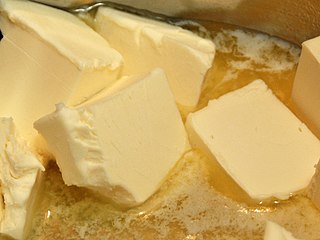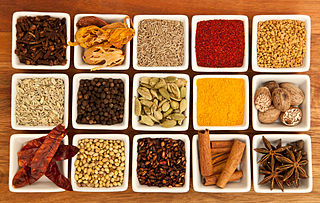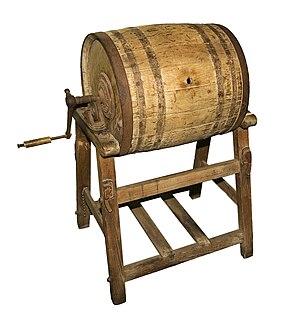
The cuisine of the Southern United States developed in the traditionally defined American South. Tidewater, Appalachian, Cajun, Creole, Lowcountry, and Floribbean are examples of types of Southern cuisine. In recent history, elements of Southern cuisine have spread north, having an effect on the development of other types of American cuisine.

Butter is a dairy product made from the fat and protein components of milk or cream. It is a semi-solid emulsion at room temperature, consisting of approximately 80% butterfat. It is used at room temperature as a spread, melted as a condiment, and used as an ingredient in baking, sauce making, pan frying, and other cooking procedures.

A pancake is a flat cake, often thin and round, prepared from a starch-based batter that may contain eggs, milk and butter and cooked on a hot surface such as a griddle or frying pan, often frying with oil or butter. Archaeological evidence suggests that pancakes were probably the earliest and most widespread cereal food eaten in prehistoric societies.

Buttermilk is a fermented dairy drink. Traditionally, it was the liquid left behind after churning butter out of cultured cream; most modern buttermilk is cultured, however. It is common in warm climates where unrefrigerated fresh milk sours quickly.

Cornbread is any quick bread containing cornmeal, and a Native American cuisine. They are usually leavened by baking powder.

Punjabi cuisine is a culinary style originating in the Punjab, a region in the northern part of the Indian subcontinent, which is now divided in an Indian part and a Pakistani part. This cuisine has a rich tradition of many distinct and local ways of cooking. One is a special form of tandoori cooking that is now famous in other parts of India, UK, Canada, Hong Kong and in many parts of the world.

Corn on the cob is a culinary term used for a cooked ear of freshly picked maize from a cultivar of sweet corn. Sweet corn is the most common variety of maize eaten directly off the cob. The ear is picked while the endosperm is in the "milk stage" so that the kernels are still tender. Ears of corn are steamed or boiled, usually without their green husks, or roasted with them. The husk leaves are in any case removed before serving.

Boxty is a traditional Irish potato pancake. The dish is mostly associated with the north midlands, north Connacht and southern Ulster, in particular the counties of Leitrim, Mayo, Sligo, Donegal, Fermanagh, Longford, and Cavan. There are many recipes but all contain finely grated, raw potatoes and all are served fried.

A butter churn is a device used to convert cream into butter. This is done through a mechanical process, frequently via a pole inserted through the lid of the churn, or via a crank used to turn a rotating device inside the churn.

Jameed is a Beduin-Jordanian food consisting of hard dry laban made from ewe or goat's milk. Milk is kept in a fine woven cheesecloth to make a thick yogurt. Salt is added daily to thicken the yogurt even more and the outside of the yogurt-filled cheesecloth is rinsed with water to allow any remaining whey to seep through. After a few days of salting the yogurt, it becomes very dense and can be removed from the cheesecloth and shaped into round balls. It is then set to dry for a few days. If it is dried in the sun it becomes yellow; if it is dried in the shade it remains white. It is important that the jameed is dry to the core because any dampness can spoil the preservation process. Jameed is the primary ingredient used to make mansaf, the national dish of Jordan.

Churning is the process of shaking up cream or whole milk to make butter, usually using a butter churn. In Europe from the Middle Ages until the Industrial Revolution, a churn was usually as simple as a barrel with a plunger in it, moved by hand. These have mostly been replaced by mechanical churns.

In a dairy, the creamery is the location of cream processing. Cream is separated from whole milk; pasteurization is done to the skimmed milk and cream separately. Whole milk for sale has had some cream returned to the skimmed milk.

Kashk is a range of dairy products used in cuisines of Iranian, Turkish, Mongolian, Central Asian, Transcaucasian and the Levantine peoples. Kashk is made from drained yogurt or drained sour milk by forming it and letting it dry. It can be made in a variety of forms, including rolled into balls, sliced into strips, and formed into chunks.

Country ham is a variety of heavily salted ham preserved by curing and smoking, associated with the cuisine of the Southern United States. Used as a method of preservation from before widespread refrigeration, country ham is packed in a mixture of salts, sugar, and spices and allowed to cure for a long period of time, sometimes months, and often smoked afterwards. It is extremely dry and salty, often too salty to be palatable on its own. Most preparations call for a long soak prior to preparation so that much of the salt can be removed and the ham rehydrated. Commercially available country hams may be sold whole as-is, soaked but uncooked, or cooked and ready to eat. Country ham is often contrasted with wet-cured hams known as city ham in areas of the U.S. where both types of ham are available.

Tibetan cuisine includes the culinary traditions and practices and its peoples. The cuisine reflects the Tibetan landscape of mountains and plateaus and includes influences from neighbours. It is known for its use of noodles, goat, yak, mutton, dumplings, cheese, butter, yoghurt and soups. Vegetarianism has been debated by religious practitioners since the 11th century, but is not prevalent due to the difficulty of growing vegetables, and cultural traditions promoting consumption of meat.

Chaas is a dahi (yogurt)-based drink popular across Indian subcontinent. It is also written chhaachh. In the Bengal region of the Indian subcontinent, it is called ghol. It is called moru മോര് in Tamil and Malayalam, taak ताक in Marathi, majjiga in Telugu, majjige in Kannada, ale in Tulu. It is often called laban in the Old Dhaka in Bangladesh. In Indian English, it is often referred to as buttermilk.

Túrós csusza is a traditional Hungarian savoury curd cheese noodle dish made with small home-made noodles or pasta.

A biscuit in the United States and Canada, is a variety of small baked goods with a firm browned crust and a soft, crumbly interior. They are usually made with baking powder or baking soda as a chemical leavening agent rather than yeast. They developed from hardtack which was first made from only flour and water, with later first lard and then baking powder being added. Biscuits, soda breads, and cornbread, among others, are often referred to collectively as "quick breads", to indicate that they do not need time to rise before baking.

Yayık ayranı, also known as Turkish buttermilk, is a traditional Turkish drink produced from fermented buttermaking by-products, water and salt. It has been traditionally prepared in barrel churns or skin bags. Despite the similar name, it is distinct from ayran. Goat, sheep, or cow's milk can be used for Turkish buttermilk production. Certain acid curd cheeses such as çökelek could also be obtained from yayık ayranı when heated.



















